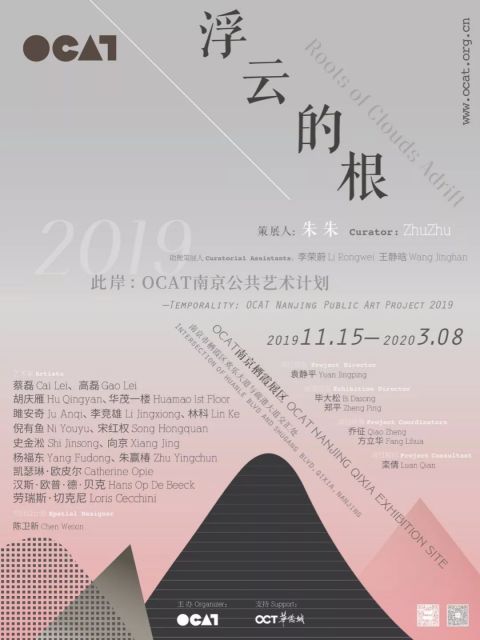
“OCAT Nanjing Qixia Public Art Project”, a long-term public art project designed for the exhibition area of OCAT Nanjing, aims at creating a top-notch public art landscape of China by integrating the socio-cultural ecosystem of Nanjing with the architectural layout of OCT Qixia Project—a cultural and tourist holiday resort real estate project to be constructed in sync with the Qixia Public Art Project. The public art project, as part of the efforts to build the new landmark of urban culture, is also dedicated to bringing pure and cutting-edge contemporary art into Nanjing.
Traditionally known as the “Ancient Capital for Six Dynasties”, Nanjing has bestowed the project with abundant classical resources and topics. To make the best use of them and to guard against the narrow-minded and empty regional nostalgia, the organizer will unroll their discussions in a holistic cultural context by addressing the literary, philosophical, historical, architectural and chorographic dimensions of the city while unifying senses with sensibilities. The cross-disciplinary collaborations of the project will never let their guard down against the abuses of supplanting personal experiences with knowledge system of any kind, sustaining an in-depth differentiation of the connections and contrasts between the roles of artists and that of the traditional literati and contemporary intellectuals.
Each edition’s “OCAT Nanjing Qixia Public Art Project” features a particular subject and form. Every year, internationally-renowned artists from China and other countries will be selected to make public art in the designated area of the OCT Project in Qixia District, where their works will blend seamlessly into the geographical, recreational and residential space of the area in an effort to transform this area into a first-rate outdoor art museum. This project will encompass exhibitions and public projects of various forms.
Mr. Zhu Zhu, the well-known art critic and curator was invited to curate the project, who has proposed a three-year public art proposal known as “Temporality— Qixia Public Art Project, OCAT Nanjing”.
“Temporality”, emphasizes creative understandings and expressions on “Now and Here”, championing review and reexamination of the historic heritage, traditional values and modernization through artistic practices. Such emphasis on temporality will be exemplified by “Roots of Clouds Adrift”, the second themed exhibition for this ambitious art project.
The exhibition title alludes to the phrase “cloud-roots,” which has multiple meanings in classical Chinese. It refers to mountainous terrain from which clouds arise; it can also refer to mountain-like rockeries in gardens; it can also refer to monastery buildings. For traditional Chinese literati, visiting old temples on legendary mountains was always a favorite activity, and it offered a way to ponder and express themselves in an expansive setting. Qixia Mountain, which is adjacent to the exhibition site, has long been characterized as “a nexus of Nanjing’s history” and “a geological museum.” This mountain not only gives a special view of the ancient city, but it also gives a window upon geographical and historical changes that have affected Chinese civilization overall. In this modern-day environment filled with unsettledness and displacement, the loss of connection with tradition and nature has set us adrift like floating clouds. How can we regain roots to a spiritual homeland, or should we say, how can contemplative dialogue serve as a possible means to reconfigure our cultural disorder and confusion? These questions constitute an important premise for further inquiry. As the British sociologist Mike Featheringstone wrote in his book Undoing Culture, “It is precisely this ongoing fact of relocation and migration, to which some people have attached the label ‘post-modern,’ which is considered to be both a methodological key and a real-life description of the contemporary world.”
This exhibition will strike a note of thematic counterpoint with the previous year’s exhibition “A Flowing Book,” which focused on the element of water. It is both a refrain and a variation on the Chinese cultural theme of landscape (i.e., “mountains and streams”).
Under the premise of respecting the artists’ consistent creative context, the exhibition was bred and structured a kind of artistic creation in dialogue style. The form and composition of the exhibition not only covers installation, sculpture and video art, but also extends to sound art and performance art.
This year, the organizer focuses on the most energetic artists in China, and invites the local independent art institution — “Huamao First Floor”, graphic designer and artist — Zhu Yingchun as participant, as well as, the architect —Chen Weixin to do the space design.
About the exhibition
Dates: Nov 15, 2019 – Mar 8, 2020
Opening: Nov 15, 2019, 16:00
Venue: OCAT Nanjing Qixia Exhibition Site
Artists: Cai Lei, Loris Cecchini, First Floor, Gao Lei, Hu Qingyan, Ju Anqi, Li Jingxiong, Lin Ke, Ni Youyu, Hans Op de Beeck, Catherine Opie, Shi Jinsong, Song Hongquan, Xiang Jing, Yang Fudong, Zhu Yingchun
Courtesy of the Organizer.




























